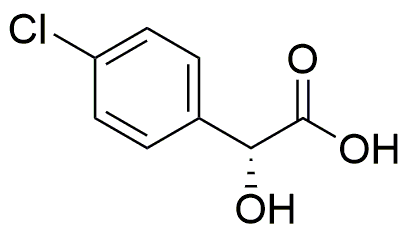4-Chloro-D-mandelic acid is widely utilized in research focused on:
- Pharmaceutical Development: This compound serves as an important intermediate in the synthesis of various pharmaceuticals, particularly in the development of anti-inflammatory and analgesic drugs.
- Chiral Synthesis: Its chiral nature makes it valuable in asymmetric synthesis, allowing chemists to create specific enantiomers that are crucial in drug formulation.
- Analytical Chemistry: Used as a standard in chromatographic techniques, it aids in the quantification of other compounds, ensuring accurate analysis in quality control processes.
- Cosmetic Formulations: The compound is incorporated into skincare products for its potential skin-soothing properties, enhancing the effectiveness of formulations aimed at sensitive skin.
- Research in Biochemistry: It is utilized in studies exploring metabolic pathways and enzyme interactions, providing insights into biochemical processes relevant to health and disease.
Informations générales
Propriétés
Sécurité et réglementation
Applications
4-Chloro-D-mandelic acid is widely utilized in research focused on:
- Pharmaceutical Development: This compound serves as an important intermediate in the synthesis of various pharmaceuticals, particularly in the development of anti-inflammatory and analgesic drugs.
- Chiral Synthesis: Its chiral nature makes it valuable in asymmetric synthesis, allowing chemists to create specific enantiomers that are crucial in drug formulation.
- Analytical Chemistry: Used as a standard in chromatographic techniques, it aids in the quantification of other compounds, ensuring accurate analysis in quality control processes.
- Cosmetic Formulations: The compound is incorporated into skincare products for its potential skin-soothing properties, enhancing the effectiveness of formulations aimed at sensitive skin.
- Research in Biochemistry: It is utilized in studies exploring metabolic pathways and enzyme interactions, providing insights into biochemical processes relevant to health and disease.
Documents
Fiches de données de sécurité (FDS)
La FDS fournit des informations de sécurité complètes sur la manipulation, le stockage et l’élimination du produit.
Spécifications du produit (PS)
Le PS fournit une description complète des propriétés du produit, notamment sa composition chimique, son état physique, sa pureté et les exigences de stockage. Il détaille également les plages de qualité acceptables et les applications prévues du produit.
Certificats d'analyse (COA)
Recherchez des certificats d'analyse (COA) en saisissant le numéro de lot du produit. Les numéros de lot et de lot se trouvent sur l'étiquette d'un produit, après les mots « Lot » ou « Lot de fabrication ».
Numéro de catalogue
Numéro de lot/série
Certificats d'origine (COO)
Ce certificat d'exploitation confirme le pays dans lequel le produit a été fabriqué, et détaille également les matériaux et composants utilisés et s'il est issu de sources naturelles, synthétiques ou autres sources spécifiques. Ce certificat peut être requis pour les douanes, le commerce et la conformité réglementaire.
Numéro de catalogue
Numéro de lot/série
Fiches de données de sécurité (FDS)
La FDS fournit des informations de sécurité complètes sur la manipulation, le stockage et l’élimination du produit.
DownloadSpécifications du produit (PS)
Le PS fournit une description complète des propriétés du produit, notamment sa composition chimique, son état physique, sa pureté et les exigences de stockage. Il détaille également les plages de qualité acceptables et les applications prévues du produit.
DownloadCertificats d'analyse (COA)
Recherchez des certificats d'analyse (COA) en saisissant le numéro de lot du produit. Les numéros de lot et de lot se trouvent sur l'étiquette d'un produit, après les mots « Lot » ou « Lot de fabrication ».
Numéro de catalogue
Numéro de lot/série
Certificats d'origine (COO)
Ce certificat d'exploitation confirme le pays dans lequel le produit a été fabriqué, et détaille également les matériaux et composants utilisés et s'il est issu de sources naturelles, synthétiques ou autres sources spécifiques. Ce certificat peut être requis pour les douanes, le commerce et la conformité réglementaire.


